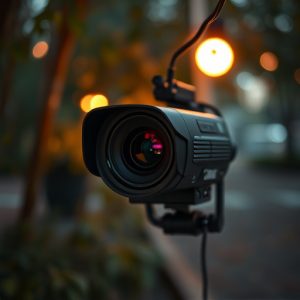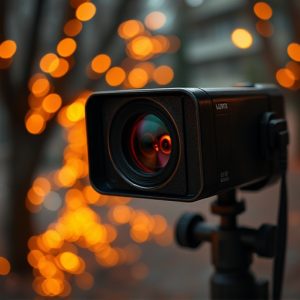Mastering Mini Surveillance Camera Detection in Apartments
Mini surveillance cameras for apartments rely on electromagnetic signals for data transmission, maki…….
Mini surveillance cameras for apartments rely on electromagnetic signals for data transmission, making signal detection crucial for maintaining privacy and security. When choosing these cameras, prioritize discretion with compact designs, infrared night vision, and suitable field of view/resolution. For effective detection, strategically place a signal detector near interference sources and elevate it for better coverage. Advanced techniques like signal amplifiers, filters, SDRs, shielding, or optimizing reception can significantly improve the success rate in locating hidden mini surveillance cameras in apartments.
Uncover the secrets of invisible surveillance with our guide on detecting electromagnetic signals from mini surveillance cameras in apartments. In an era where privacy is paramount, understanding how these devices operate is key to maintaining your peace of mind. We’ll delve into the fundamentals of electromagnetic signals, explore tailored camera choices for apartment settings, and master positioning techniques for optimal detection. Additionally, discover advanced tips using external tools and environmental factors to enhance your surveillance capabilities.
- Understanding Electromagnetic Signals: A Foundation for Detection
- Choosing the Right Mini Surveillance Camera for Apartment Settings
- Positioning and Placement Techniques for Optimal Signal Reception
- Advanced Tips: Enhancing Detection with External Tools and Environment Considerations
Understanding Electromagnetic Signals: A Foundation for Detection
Electromagnetic signals are an integral part of our modern world, particularly with the widespread use of technology like mini surveillance cameras for apartments. These signals, generated by electronic devices, can provide valuable information when it comes to detecting hidden or unauthorized equipment. Understanding how these signals work is crucial for anyone looking to employ detection methods.
Mini surveillance cameras, for instance, emit electromagnetic radiation as they transmit video and audio data. By learning to recognize typical frequency ranges and signal patterns, individuals can better detect such devices. This knowledge allows for proactive measures to ensure privacy and security in residential spaces or any environment where discreet monitoring is necessary.
Choosing the Right Mini Surveillance Camera for Apartment Settings
When selecting a mini surveillance camera for an apartment setting, it’s crucial to balance discreetness with effective monitoring. Opt for cameras that blend seamlessly into their environment; small, compact designs can easily be hidden away in common areas like living rooms or kitchens, or even attached to everyday objects like books or door handles. Look for models with infrared night vision to ensure 24/7 surveillance without compromising privacy during the day.
Consider also the camera’s field of view and resolution. A wider FOV provides a broader area of coverage, while higher resolution ensures clear, detailed footage. Wireless options offer added flexibility, allowing you to position cameras strategically without the hassle of cables. Always check for compatibility with your existing surveillance system or monitoring app for seamless integration and remote access.
Positioning and Placement Techniques for Optimal Signal Reception
When it comes to detecting electromagnetic signals from mini surveillance cameras in apartments, proper positioning and placement are key to achieving optimal signal reception. For best results, place the signal detector near potential sources of interference, such as large metal objects or other electronic devices, as these can disrupt signals. Additionally, ensure the detector is positioned high up, away from walls and floors, as electromagnetic waves often reflect off these surfaces, leading to weaker signals.
Consider using a multi-directional antenna for wider coverage if you’re searching for signals from multiple sources simultaneously, like hidden mini surveillance cameras in apartments. The placement of the detector should also account for line-of-sight access to the devices being monitored. Direct line-of-sight often results in stronger and more reliable signal reception compared to indirect paths where signals can be blocked or weakened by obstacles. Regularly adjusting the detector’s position based on these factors will help maintain consistent and high-quality surveillance.
Advanced Tips: Enhancing Detection with External Tools and Environment Considerations
When it comes to detecting mini surveillance cameras in apartments, advanced users can enhance their capabilities with external tools and by considering the environment. One effective approach is leveraging signal amplifiers and filters, which can strengthen electromagnetic signals, making hidden cameras easier to pinpoint. These devices are particularly useful in dense urban environments where signal interference is common.
Additionally, understanding the electromagnetic spectrum and the specific frequencies used by mini surveillance cameras allows for more targeted detection. Some professionals use software-defined radios (SDRs) to scan for these signals, providing a high-tech edge in identifying hidden camera locations. Customizing your detection environment, whether it’s through shielding or optimizing the space for signal reception, can significantly improve success rates in locating these clandestine devices, ensuring privacy and security in apartments.
When it comes to detecting electromagnetic signals from mini surveillance cameras in apartment settings, understanding the fundamentals of signal behavior and choosing the right equipment are key. By strategically positioning these compact devices and utilizing advanced tools, you can significantly enhance your detection capabilities. Remember that optimal results with Mini Surveillance Cameras for Apartments depend on a combination of technical proficiency and environmental awareness, ensuring effective monitoring and peace of mind.


